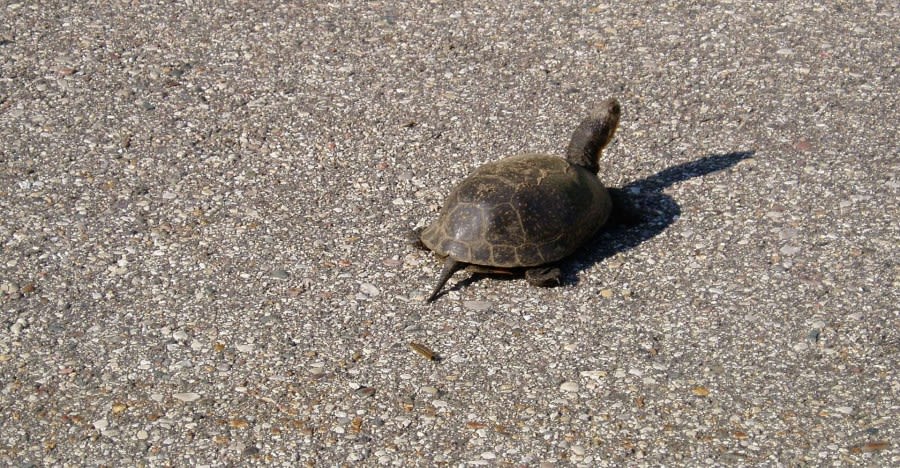Search results
Turtles, or testudines, are reptiles of the order Testudines, characterized by a special shell developed mainly from their ribs. Modern turtles are divided into two major groups, the Pleurodira (side necked turtles) and Cryptodira (hidden necked turtles), which differ in the way the head retracts.
- Turtle (Disambiguation)
Turtle Mountain (Alberta), Canada United States. Turtle,...
- Cryptodira
Skull of a cryptodiran turtle from the family Emydidae...
- Platysternidae
The big-headed turtle is known to readily climb over...
- Snapping Turtles
The Chelydridae is a family of turtles that has seven...
- Chersobius Signatus
Main page; Contents; Current events; Random article; About...
- Brumation
During winter dormancy, plant metabolism comes to a virtual...
- List of Testudines Families
There are fourteen extant families of the order Testudines,...
- Sea Turtles
Sea turtles (superfamily Chelonioidea), sometimes called...
- Leatherback Turtle
The leatherback sea turtle (Dermochelys coriacea), sometimes...
- Turtle Shell
The turtle shell is a shield for the ventral and dorsal...
- Turtle (Disambiguation)
Sea turtles (superfamily Chelonioidea), sometimes called marine turtles, are reptiles of the order Testudines and of the suborder Cryptodira. The seven existing species of sea turtles are the flatback, green, hawksbill, leatherback, loggerhead, Kemp's ridley, and olive ridley.
The green sea turtle (Chelonia mydas), also known as the green turtle, black (sea) turtle or Pacific green turtle, is a species of large sea turtle of the family Cheloniidae. It is the only species in the genus Chelonia.
- Names
- Life
- Body
- Evolution
Although the word turtle is widely used to describe all testudines, it is also common to see them called terrapins, tortoises or sea turtles. How these names are used depends on the type of English. 1. British Englishcalls them turtles if they live in the sea, or "terrapins" if they live in fresh water. They are called "tortoises" if they live on l...
Although many turtles spend a lot of their lives underwater, all turtles and tortoises breathe air and must come to the surface to refill their lungs. Some spend their whole lives on dry land. Aquatic respiration in Australian freshwater turtles is being studied. Some kinds of turtle have large cloacal holes that are lined with many finger-like thi...
Neck folding
Turtles are put into two groups from the way they hide their heads into their shells. The Cryptodira (hidden neck turtles) pull their heads straight into their shells by folding their necks back under their spines. They have very small necks. The Pleurodira (side-necked turtles), now found only in fresh water places in the Southern hemisphere, fold their necks to the side. The important adaptation of hiding their heads came from turtles in the past which were not able to do this. This adds to...
Feeding
Turtles have a hard beak. They use their jaws to cut and chew food. Turtles have hard edges called horny ridges that cover their upper and lower jaws. These ridges are different from teeth, which turtles do not have. Carnivorous turtles tend to have knife-sharp ridges that help them cut through meat. Herbivorous turtles have serrated-edged ridges that help them cut through tough plants. Turtles use their tonguesto swallow food, but unlike most reptiles, they cannot stick out their tongues to...
Shell
The upper shell of the turtle is called the carapace. The lower shell that covers the belly is called the plastron. The carapace and plastron are joined on the turtle's sides by bony structures called bridges. The inside of a turtle's shell has about 60 bones. It includes parts of the spineand ribs, meaning the turtle cannot crawl out of its shell.
The earliest turtle fossils come from Upper Triassic of the Mesozoic era, about 220 million years ago. Their shell came from bony extensions of their backbones and broad ribs that became larger and grew together to make a complete shell. This adaptation was very useful and has been around for a long time. It helped protect turtles as they evolved o...
News about New York, DEC, turtles
News about sea turtles, Iolani School, Maddux Springer
Also in the news
Apr 23, 2024 · Learn about turtles, reptiles with a body encased in a bony shell, including tortoises. Find out how many species of turtles there are, where they live, what they eat, and how they are threatened by human activities.
Sea turtles (Chelonioidea) are turtles found in all the world's oceans except the Arctic Ocean, and some species travel between oceans. The term is US English. In British English they are simply called "turtles"; fresh-water chelonians are called "terrapins" and land chelonians are called tortoises. The earliest known turtles are from the ...
The loggerhead sea turtle is the world's largest hard-shelled turtle, slightly larger at average and maximum mature weights than the green sea turtle and the Galapagos tortoise. It is also the world's second largest extant turtle after the leatherback sea turtle.

